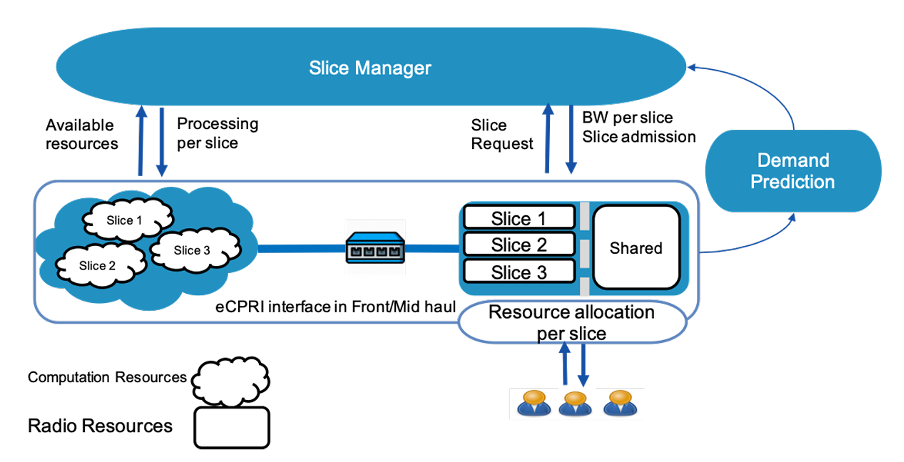AI4GREEN Main Achievents
Scroll down to check out the main achievements of the project.
-
TURKCELL / PI WORKS
In mobile networks, the capacity of sites is planned and organized based on high utilization forecasts of regional daily traffic demand. This means, during the day, especially at night, it is obvious that there are many sites working in underutilization mode. Turkcell and PI Works aimed to turn off carriers during predicted underutilization hours by considering the quality-of-service metrics and customer experience in an automated way. A method named as the Neighbour Based Expert System Solution was developed. Here, ensemble ML models are used to predict the location of users. Geolocation data was used to validate the methodology, by observing the effects of turning off the sectors. During live network tests, 6.5% energy saving achieved between 2 AM and 6 AM. The proposed method improved the existing energy saving solutions by up to 10%.
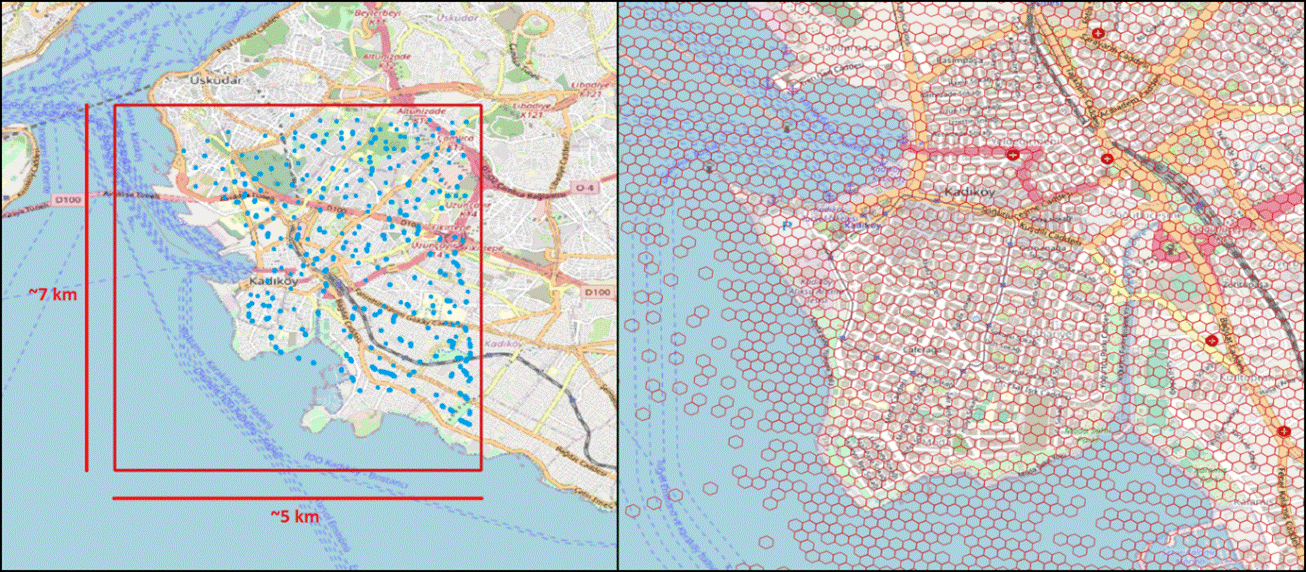
PI Works also focused on crowd movement modeling for handling the impact of live events. Planned events have a big impact on the RAN, which requires SON or RIC platforms to be aware of this impact and orchestrate energy-saving and capacity adjustment actions accordingly. We developed a solution for crowd movement modeling based on recurrent graph neural network architecture and implemented it to predict the next five hours of the RAN measurements at the start of a football match. To show the effectiveness of the approach presented here, the potential energy saving during a special event where operators generally avoid energy saving altogether is calculated and compared with ground truth. 52.5% of the time, the energy saving algorithms can be used during a special event. As a result, the algorithm achieved 6% energy saving in a normal day, and 3.2% during a special event.

-
Celfinet
Solution Overview
VISMON ENERGY is a CELFINET Energy Management (EM) solution. It allows to measure and track with precise accuracy and high granularity the Power that is consumed on the RAN part of the network. This solution is completely agnostic in terms of RAN Hardware suppliers (Ericsson, Huawei and Nokia) being able to work in multi-technology (2G, 3G, 4G and 5G) environments with outstanding results. Having a lean and simple architecture allows the solution to meet most operators’ demands and easily evolve if necessary. The solution follows a multi-layer architecture based on three main layers: Data Collection, Data Analytic and Data Analysis.
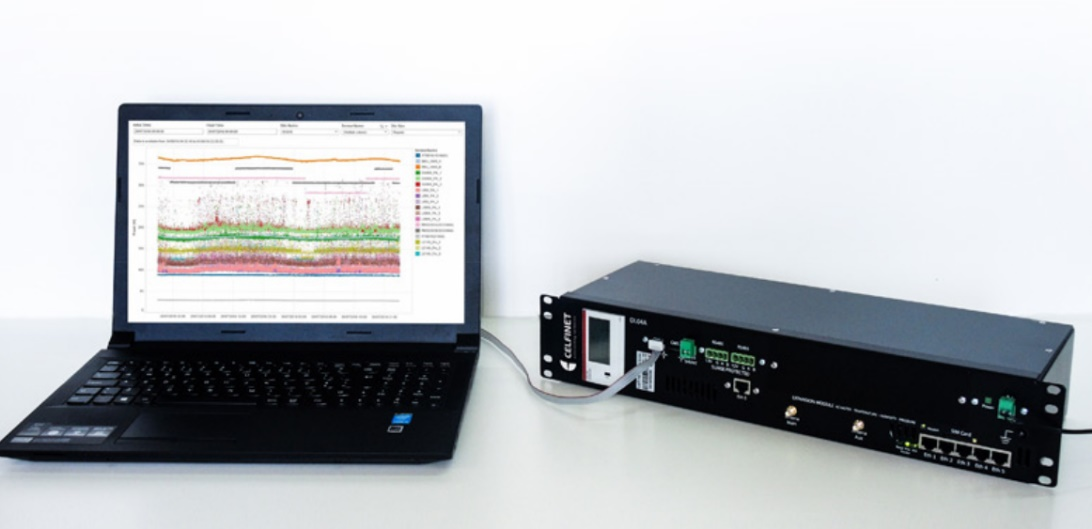
Validation in Real Networks
For the energy consumption analysis, the base station (Site A) from a Spanish mobile operator was monitored by the VISMON Energy probes, on top of the building at 43m of altitude. The solution monitored all technologies and all configured bands in each of the three different sectors, during a month. This site is configured with 5G at 3.5 GHz, 4G in three bands (800, 1800 and 2600 MHz), 3G at 2100 MHz and 2G / 3G in a shared 900 MHz band. With a typical configuration scenario, this site is full of technologies and bands. Figures show the energy consumption for 5G and 4G (L2600), considering energy saving features.
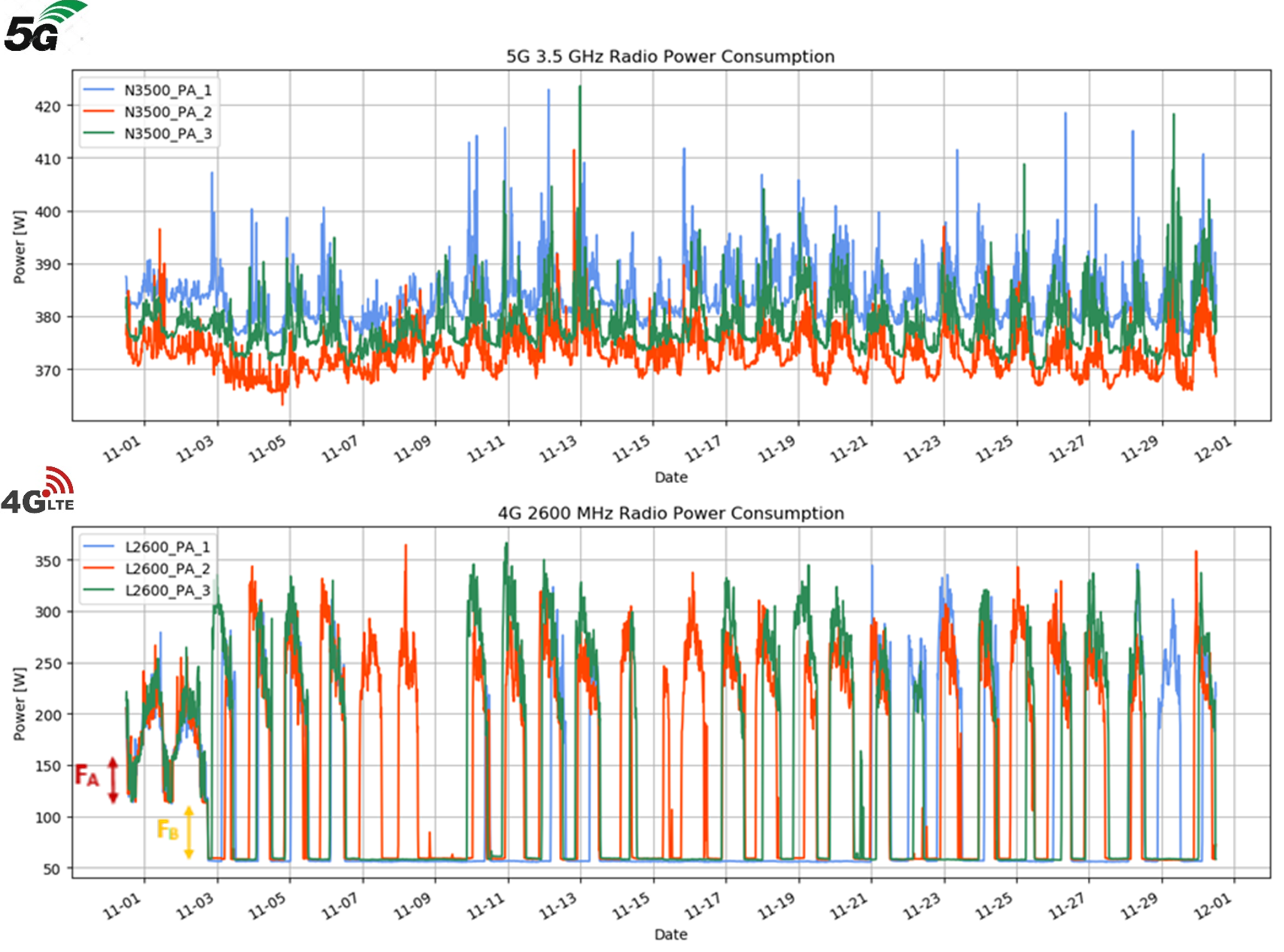
• The solution allows to measure with precision the 5G power consumption
• Different baselines on the radio power consumption are observed
• The radios can have different configured transmitted power, software versions or different loads during the tests
• Also, it was monitored all LTE radios
• The power consumption follows the traffic pattern
• Power saving features (Huawei) are activated: FA: CellRfShutdown (25% saving); FB: CellShutdown (50% saving)
Visualization Platform
A common visualization platform was performed under the project, which allows to join the energy and the performance management modules, from two different partners (CELFINET and ALLBESMART). The platform permits to analyse the energy consumption of a site, per technology, band, or radio equipment. Also, it is possible to simulate the activation of two energy saving features of LTE, measuring the saving costs. In addition, a switch-off scenario of a legacy 3G band can be simulated, obtaining the energy savings. These simulations can be followed with the network performance analysis.

Main Achievements
Focusing on the main objective of the AI4GREEN project, within this use case it was verified that the energy saving features, applied to radio equipment, are crucial to the reduction of the network energy consumption. The features must be implemented during low traffic time-periods (0h to 6h) to reduce the impact on the system performance. It was observed that vendor features such as Micro Sleep and cell Sleep Mode allow to save up to 14.2% of the 4G energy consumption. Using the energy saving mechanisms in a whole network (applied only in 4G), a reduction of 4.11 GWh in the total energy consumption (around of 4.64%) can be obtained, which corresponds to an annual saving of 0.51 M€ (considering 0.125 €/kWh).
Also, it was verified that the traffic migration from 3G to 4G leads to an insignificant increase of its energy consumption and the impact on the cell capacity is very residual. The 3G U2100 switch-off allows to save 14.71% of the total site energy consumption.
It was also found that the introduction of the 5G technology will increase the global energy consumption of the sites, being the most expensive. However, in terms of efficiency by bandwidth, the 5G performance is much better than the legacy technologies. It can be concluded that the operators have to proceed with the legacy technology switch-off and activate the energy saving features, especially in capacity bands.
-
Allbesmart

When measuring in live the performance of commercial networks with paying subscribers, it is paramount that the measurements be as unobtrusive as possible to avoid impacting subscribers’ quality of experience (QoE). Moreover, active measurements in drive tests come with the OPEX associated to data plans for SIM cards that needs to be minimized. In AI4GREEN we do an experimental validation of a non-intrusive approach for predicting the performance of 4G/5G radio links without active transmission. This approach will be included in the UXPERT framework to decrease the costs associated to drive tests. The combination of UXPERT with powerful Machine Learning algorithms to predict the wireless link performance without active transmission constitutes an undeniable competitive advantage.

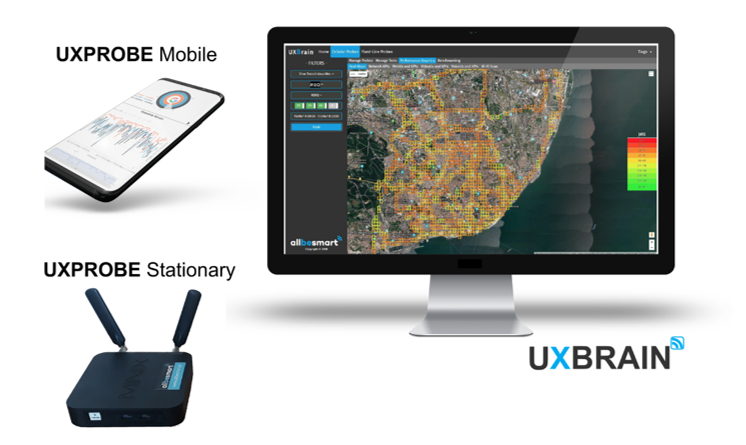
-
Infovista
Infovista tests energy saving features of 5G cellular base-station from a quality of user perspective within the AI4Green POC. The test is scheduled for September 2022 timeframe in collaboration with Tele2 Sweden.
Infovista provides test tools based on real smartphone for measuring network-related key performance indicators (KPIs) of LTE and 5G networks. The tools execute highly accurate predictive algorithms regarding cellular link throughput, cell load, and network latency. The goal of the tests within AI4Green POC is to test the performance of the deep sleep energy feature of the 5G cellular base-station. That is, combine the network-related KPIs with the energy consumption. The deep sleep feature shuts down a 5G base-station when the demand on the network is very low, usually during nights. During the sleep period, the cellular traffic is offloaded to the LTE base-station and that is where we correlate throughput, cell load, and latency to the energy consumption. In addition, once activated, the deep sleep feature requires on average 5 minutes in order to be fully operational again. During that period, we measure what happens with the energy consumption on the 5G cell. The goal of the test is to figure out the total energy savings of the deep sleep feature. The outcome is to propose a strategy in which scenarios the 5G cell should go in/out of deep sleep mode and offload the traffic to the LTE cell.
The test setup is illustrated on the figure below.
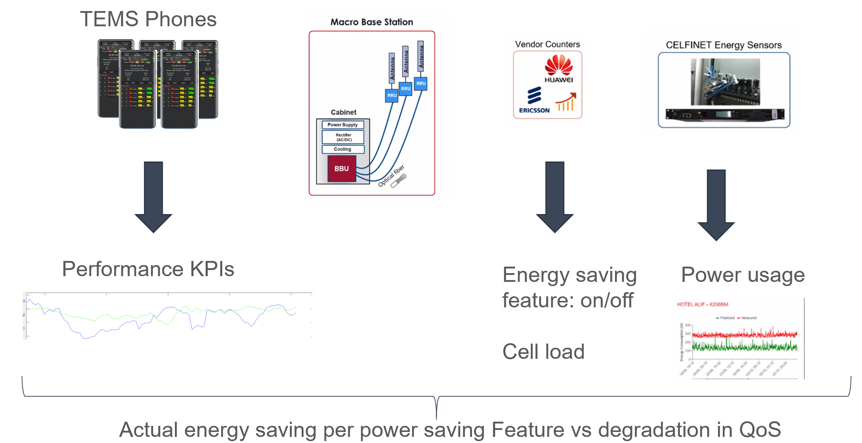
-
Turkgen
Turkgen is developing AI4GREEN PoC as a standalone solution that can be used as an add-in feature for the mobile network operators. Mobile network operators can use this tool to plan and optimize their networks. By using this tool they can manage their energy consumption and also support the networks urgently with portable base-stations where the event takes place.
Another solution that Turkgen is developing is to present all detected public event activities to end users via a mobile application. This app will be a city activity map which does not exist as a feature in the current most used apps such as yandex or Google maps. This app can be a socialization point for the users in the cities where they live. The revenue model here will be provided by "In-App Ad Display" or "Negotiated Sponsored Ads".
Finally the economic model is to position the outcome of the AI4GREEN project outcome as a SaaS (Software as a Service) and provide this service to potential business users which cannot provide this service theirself such as yandex, Google maps, Istanbul Municipality Mobile Traffic, etc.
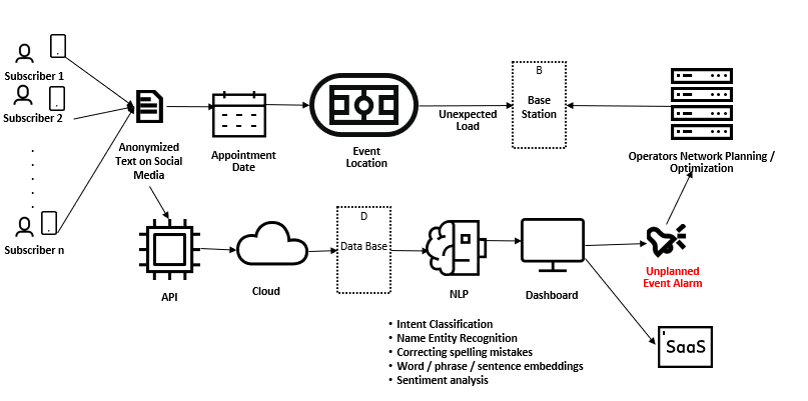
-
University of Oulu
Ray tracing is an effective and accurate method for 3D wireless propagation channel modelling. In the developed model exact radio paths between transmitters/receiver pairs can be calculated with corresponding electromagnetic field vectors. The tool can be used in conjunction with AI & ML algorithms to decrease the energy consumption of wireless networks. For example, network planning, radio resource management, beamforming and interference mitigation would benefit from the intelligent processing of the input data from the ray tracing tool. The figure below shows a snapshot of the 3D tray tracing simulation demo in an exemplary scenario.
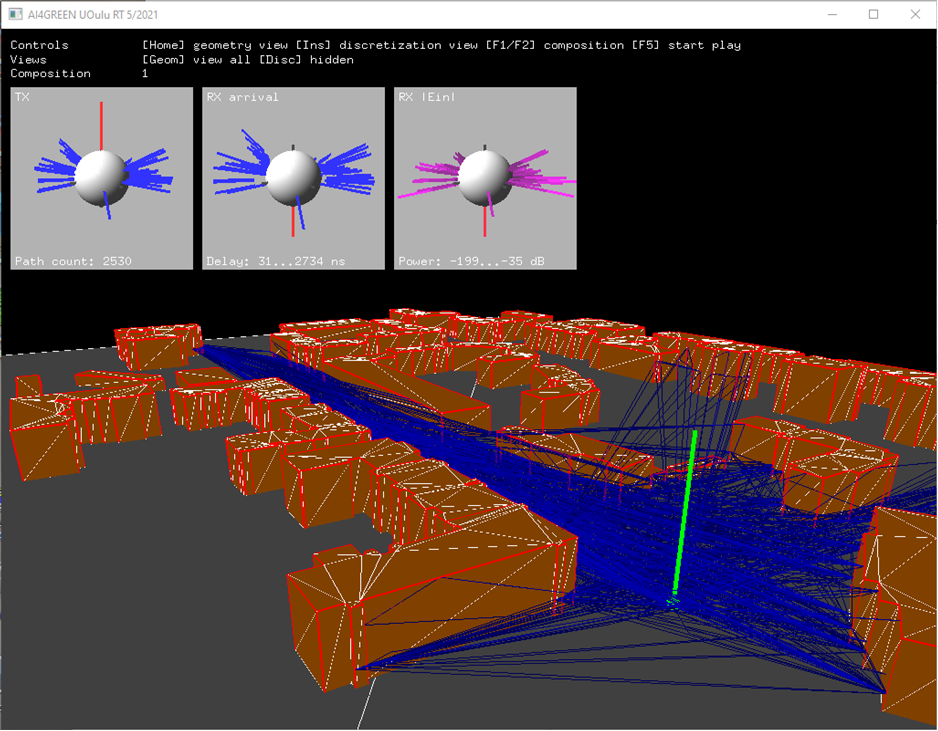
-
VTT
Instead of having separate communication and sensing devices, VTT considers whether the communication waveform such as the 5G can be also used as a radar. The 5G radar is a spectral and energy efficient technique to maximize technology commonalities. If the same transmit power is used for both data transmission and radar, the energy saving is 50 % compared to the case of separate radar and communication devices. Clustering is a form of statistical analysis that groups, e.g., sensed objects together based on how much they resemble each other. One problem with clustering is that most clustering algorithms force a grouping on a data set, which is not naturally clusterable. VTT has created a computational model for the assessment of clusterable structure in the given data. The approach of VTT consists of a multimodal, convolutional neural network (MCNN) to assess the clusterability of a data set. The method can also assist in the visual inspection of the data and in the selection of a suitable clustering algorithm. By assessing the clusterability of the data before the clustering analysis, one can avoid the forced, incorrect groupings in the clustering analysis.

Illustration of the 5G radar and the multimodal, convolutional neural network (MCNN) to assess the clusterability of a data set.
-
KTH
Base Stations (BSs) are the most energy-consuming component of mobile networks. In our study at KTH, we investigated the energy-saving methods at the BSs to reduce its energy consumption while maintaining the provided Quality of Service (QoS). We focus on the benefiting from activating advance sleep modes where BSs can sleep for certain durations with a different level/depth of sleeping. To make the study more realistic, we obtain a data set from a mobile network operator which contains network load information. It is a challenge to use mobile network traffic data to train Machine Learning (ML) algorithms for sleep mode management decisions due to the coarse time granularity of data. We propose a method to regenerate mobile network traffic data taking into account the burstiness of arrivals. We propose ML-based algorithms to decide when and how deep to put BSs into sleep. The current literature on using ML in network management lacks of guaranteeing any quality of service. To handle this issue, we combine analytical model based approaches with ML where the former is used for risk analyses in the network. We define a novel metric to quantify risk of decision making. We design a digital twin that can mimic the behavior of a real BS with advanced sleep modes to continuously assess the risk and monitor the performance of ML algorithms. Simulation results show that using proposed methods considerable energy saving is obtained compared to the baselines at cost of negligible number of delayed users.
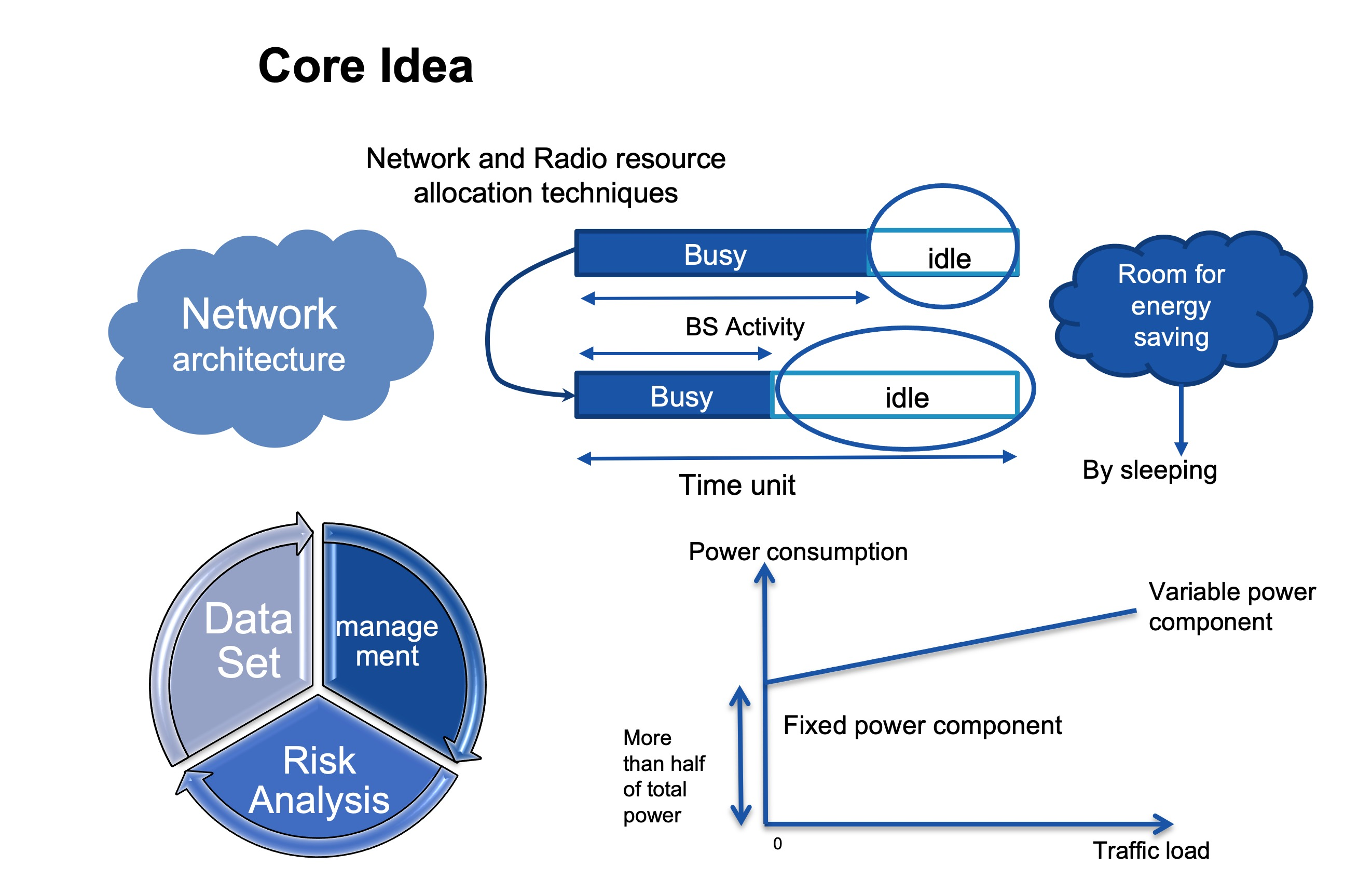
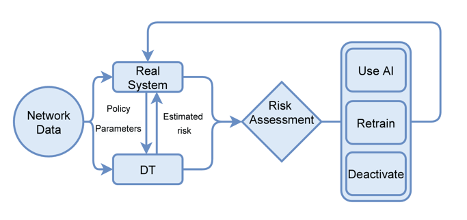
Network Slicing
5G and beyond networks are supporting and providing increasing number of services with vast and heterogeneous QoS. The service demands are evolving while the requirements are very diverse and heterogeneous. Considering this trend, one architecture does not fit for all service. The current network architecture utilizes a relatively monolithic network and transport framework to accommodate these emerging services. Network slicing can help the operators to tailor their network for specific services and dedicate network resources to the services so that all are served with satisfying QoS. With network slicing, the network is partitioned into multiple dedicated virtual networks tailored and customized for specific services. Network slicing makes it possible to create fit-for-purpose virtual networks with varying degrees of freedom for each service. It enables service-oriented resource allocation by tailoring the network resources, e.g., bandwidth and processing, to specific services. In network slicing, resources are reserved for each service and the resources are underutilized and hence not energy efficient. Hence it requires meticulous network management and resource allocation schemes to allocate resources to each slice while maintaining the network’s energy consumption as low as possible. In AI4Green, we proposed an end-to-end model to estimate the impact of slice deployment and operation on the energy consumption and delay. This study will be facilitated using collected network data and artificial intelligence techniques. In addition, ML based algorithm is employed to develop online energy-efficient optimization algorithms to allocate communication and computation resources which are usually too complex to be tackled by current optimization methods.
